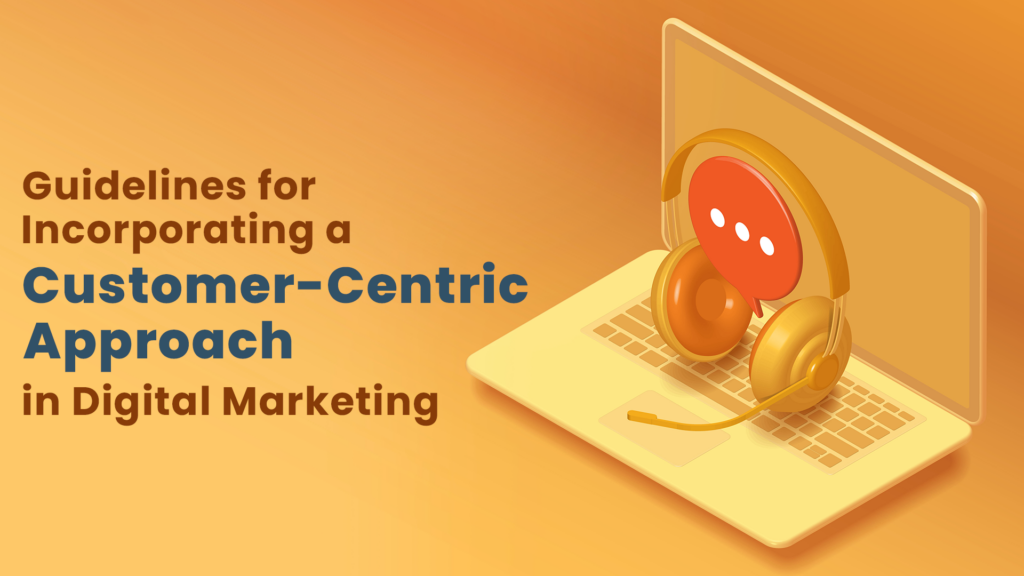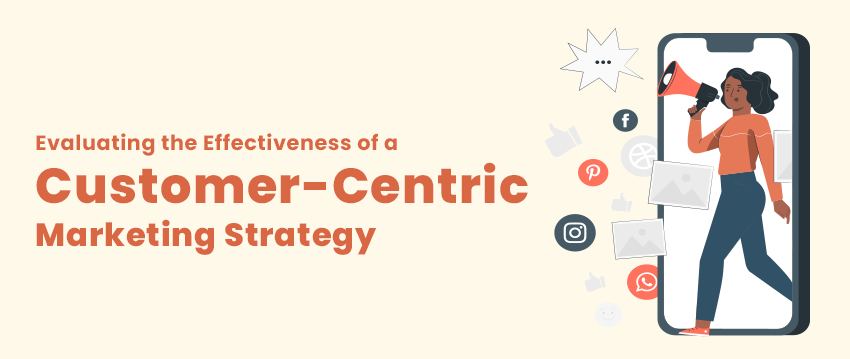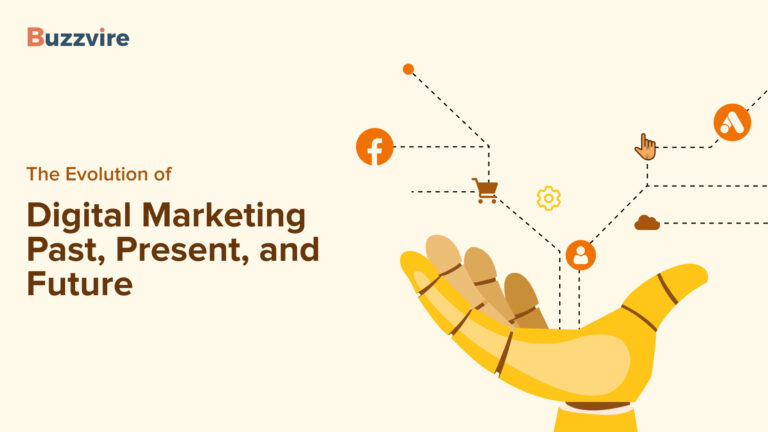Digital marketing has boomed crazily post-pandemic. However, not all digital marketing strategies work, and not all agencies are legit. The primary reason is that to make a campaign look attractive and fancy, agencies (relatively new in the industry) miss out on keeping customers at the forefront. On the other hand, digital marketing agencies that aim to enhance customer experience and curate strategies around it are likely to drive traffic and deliver the best results to their clientele. Now, the question is How to Create a Customer-Centric Digital Marketing Strategy?
In this blog, we’ll share a step-by-step guide to creating a customer-centric digital marketing strategy. However, before proceeding, let’s understand the importance of a customer-centric approach in digital marketing.
Why is a Customer-Centric Digital Marketing Strategy Important?
Every digital marketing campaign aims to increase customer awareness, create brand value and increase sales. By adopting a customer-centric approach in digital marketing campaigns, digital marketers can provide customers with a personalized customer experience. Collecting, observing, and analyzing the data help them gather insights into customer behavior. Businesses can thus enhance customer satisfaction and build loyalty and satisfaction among their customer base. Besides, this also boosts customer retention and increases the conversion rate.
A customer-centric marketing strategy gives organizations a competitive edge, which makes it highly imperative to have such a strategy in place. Businesses set themselves apart from rivals by offering outstanding customer experiences, drawing in new clients, and keeping hold of their current clientele. Additionally, the evolving digital ecosystem encourages adaptation and agility by allowing organizations to react swiftly to changes, the most recent market trends, and client behavior while ensuring that the strategies stay effective.
How is customer-centric marketing associated with increased customer loyalty and sales?
The main mantra of customer-centric marketing is to prioritize customers and create personalized and tailored experiences. Fostering a sense of emotional connection and satisfaction keeps customers loyal to the brand. Businesses must actively listen to customer feedback, respond proactively to inquiries, and address concerns to satisfy customers. This kind of understanding and service builds trust and strengthens the customer-business relationship.
Additionally, customer-centric marketing allows businesses to collect and leverage customer data and insights and identify opportunities to provide relevant recommendations, personalized offers, and targeted promotions. Moreover, customer-centric marketing strategies encourage brand promotion by sharing experiences. Satisfied customers will likely become brand advocates and spread word of mouth about their positive experiences. All of it results in repeat orders, attracting new customers, driving sales, and fostering loyalty.
Tips and tools for gaining insights into your audience

Now that you understand the importance of a customer-centric marketing approach and gaining insights into your audience, the following are the tips to gain insights into your audience effectively.
- Surveys and Feedback Forms: Surveys and feedback forms are proven effective tools for collecting customer data and feedback. Marketers use these to understand the audience’s perspective, preferences, pain points, and expectations. These real-time insights help businesses to improve their products and services and provide a customized experience to their customers.
- Social Media Analytics: The increasing use of social media platforms opened the door for marketers to gather insights into the audience’s demographic and behavioral data. Social media metrics help businesses understand which campaigns are working and help decide further action.
- Website Analytics: Website analytics tools help businesses track the audience’s behavior on the website. Analyzing visitors’ behavior on the website enables businesses to identify patterns and understand how users interact and what areas need improvement. It further allows them to make data-driven decisions.
Creating a Personalized Customer Experience
Personalized customer experience goes a long way in creating a long-term customer-business relationship. It gives businesses a human touch, and formal/informal interactions allow them to identify consumers’ pain points and provide a customized solution. Tailored solutions give customers the satisfaction of being heard and understood. It encourages brand loyalty and urges them to place repeat orders and recommend products/services to their social circles.
Examples of effective personalized marketing strategies
Personalized Email campaigns: Emails land directly in the customer’s inbox, and a well-thought-out, personalized email will likely bring results. The role of customer data in a customer-centric strategy is to make your email campaign effective. Start segmenting your email subscribers list based on the available data, such as old customers, frequent shoppers, new subscribers, etc. Be mindful of every word you put in while preparing a tailored email campaign. For instance, adding a customer’s name in the subject line, keeping the tone casual and friendly, giving personalized offers, giving away cool offers for being a loyal customer, and targeting specific interests are some of the ways to create a personalized email marketing campaign.
WhatsApp marketing is another effective personalized marketing tool. Almost every person uses WhatsApp to communicate multiple times every day. It makes WhatsApp marketing an extremely effective marketing tool. If you give a personalized experience and use it wisely, it has the potential to provide great results and conversions.
Tips for Implementing a Customer-Centric Approach in Digital Marketing

- Use websites, surveys, feedback forms, social media, purchase history records, etc., to gather as much customer data as possible. Understand consumer behavior by analyzing the data and gain insights into necessities, preferences, and desires. Leverage it to tailor your marketing messages, recommendations, and offers to match each customer’s unique characteristics and deliver a personalized experience.
- Customize communication channels! Identify communication channels your target audience actively uses and is comfortable with. These channels can include chatbots, social media platforms, push notifications, mobile applications, email, and more. Make the most of them to deliver your messages and information and provide a smooth experience. For instance, you can create personalized email campaigns, and interactive social media content, introduce unique features to mobile applications, and develop dynamic websites tailored to user choices. However, maintain the sync in the content brand’s voice and consistency across channels.
- Leverage automation tools to scale and automate personalized interactions. For instance, curate an automatic campaign for when a customer achieves a milestone or completes an action for their joining anniversary, birthday wishes, etc.
- Encouraging consumer input is another effective tip to create a personalized customer experience! You can track consumer input through surveys, reviews, or social media interactions. The idea is to show them that you value their thoughts and advice. Analyze the comments to find areas for development and personalization.
Importance of choosing the right channels to reach your target audience
Effective marketing requires selecting the best methods to reach your target market. The possibility of engagement and conversions increases since it ensures that your messages and content are sent where your audience is most active. You can choose channels that match the traits and routines of your target audience by being aware of their demographics, preferences, and behavior, maximizing the reach of your marketing initiatives, and cutting down on resource waste with a focused strategy. Additionally, you can design personalized experiences, customize messages, and optimize content for particular channels, eventually increasing audience engagement, boosting brand recognition, and increasing ROI.
How to Choose the Right Channels for Your Audience?

- Start by grasping your audience’s demographics, tastes, and behavior before selecting the appropriate channels.
- Analyze the characteristics of your target audience and the channels on which they are most active. Think about location, interests, age, and social media use.
- Determine which channels promote the greatest engagement and conversions by analyzing data from website analytics, social media insights, and customer surveys.
- Try out several channels, evaluate results, and make adjustments as necessary. Keep an eye on trends and stay informed about new platforms to guarantee that your chosen channels will resonate with your audience.
Measure the success of customer-centric marketing strategy

Following are some of the various ways to correctly measure the success of your marketing strategy.
- Set Pre-Defined KPIs (Key Performance Indicators): Select the precise measurements that support your customer-focused objectives. It could include measures for engagement such as time spent on the site, click-through rates and conversion rates, customer satisfaction scores, customer retention rates, repeat purchase rates, and referral rates. Specific and quantifiable KPIs offer a standard to measure the success of your approach.
- Track and Analyze Customer Data: Utilize analytics technologies to collect consumer interactions, preferences, and behavior information. Study the information gathered from user surveys, CRM programs, social media analysis, and website analytics to learn more about client engagement, satisfaction levels, and buying trends.
- Conduct Customer Surveys and Feedback: Utilize surveys, interviews, and feedback forms to get direct input from your customers. Evaluate the overall experience, personalization impressions, and customer happiness. Utilize Net Promoter Score (NPS) metrics to determine consumer advocacy and loyalty. Customer feedback offers insightful qualitative analysis and aids in assessing the success of your customer-centric activities.
- Monitor Customer Lifetime Value (CLV): Client-centric marketing seeks to develop long-lasting relationships and raise client lifetime value. Track CLV frequently to assess the overall effect of your approaches on client retention and revenue creation. Analyze changes in CLV over time to determine the effectiveness of your customer-centric strategy.
- Regular Reporting and Performance Analysis: Establish recurring reporting intervals to evaluate the effectiveness of your customer-centric marketing strategy. Monitoring KPIs will help you spot trends or opportunities for improvement by comparing them to benchmarks or industry standards. Based on the knowledge gleaned through performance analysis, alter your strategy.
Conclusion
The digital marketing landscape has changed dramatically post-pandemic. Marketing today is not limited to sales. Instead, it aims at building relationships with customers. Hence, it is essential to adopt customer-centric strategies to drive success. Studies have shown that agencies that prioritize customer experience and develop strategies accordingly are more likely to achieve outstanding results.
A customer-centric approach enables businesses to provide personalized experiences, gather valuable insights through data analysis, enhance customer satisfaction, build loyalty, and differentiate themselves from competitors. Moreover, focusing on customers helps businesses drive traffic, increase conversion rates, and boost customer retention.
If you are a digital marketer or an owner of a business, it is important to understand the importance of customer-centric marketing and build strategies accordingly.
FAQs
A customer-centric digital marketing strategy keeps customers at the center. It aims to recognize customer’s needs and preferences and deliver them the best possible experience. Additionally, it aims at building long-lasting relationships with customers and fostering a sense of loyalty. Aligning marketing strategies with the needs and desires of the customers drives business growth and increases conversation rates in return.
A customer-centric approach is the most crucial aspect of digital marketing, as running a business is no longer limited to sales. People are getting more aware every day and looking for enhanced experiences. Moreover, low attention spans and lack of time also make establishing a solid customer relationship essential. The only way to stay ahead of the competition in the digital era is by delivering robust customer experience and satisfaction.
There are multiple methods to gather information about your customers or target audience. Some standard consumer data collection methods are surveys, email marketing campaigns, and polls. Utilizing analytical tools for social media, search engines, and websites are additional ways to acquire customer data. However, collecting data is step one. Analyzing data and implementing the result to optimize marketing strategies will drive results.
There are several essential elements of a successful customer-centric digital marketing strategy.
They include: 1) gathering data, 2) conducting in-depth research and analysis, 3) comprehending the target audience, 4) developing personalized experiences and offers, 5) delivering relevant and engaging content, 6) collecting feedback, 7) using customer feedback to improve strategies, 8) prioritizing customer engagement and satisfaction, and 9) consistently optimizing customer journeys and marketing strategies. Together, they form a powerful customer-centric digital marketing approach that harbors long-lasting client relationships.
Digital marketing practices don’t always seek to boost sales. Thus, it is vital to establish metrics beforehand to assess the success or failure of a customer-centric marketing plan. Some methods to track and measure success are key performance indicators (KPIs), repeat purchases, customer retention rates, and referral rates, social media and website engagement analysis, and last but not least, conversion rates. A customer-centric digital marketing plan must also gather customer feedback through surveys, google reviews, social media, and other channels to be successful.




